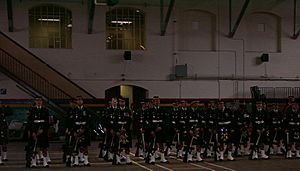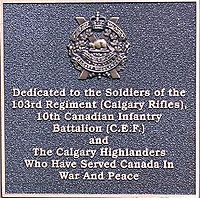Mewata Armouries facts for kids
Quick facts for kids Mewata Armoury |
|
|---|---|

Armoury entrance
|
|
| Location | 801 11th Street S.W., Calgary, Southern Alberta, Alberta, Canada |
| Built | 1915–18 |
| Architect | Thomas W. Fuller, Dominion Architect |
| Website | Mewata Armouries |
| Official name: Mewata Drill Hall / Calgary Drill Hall National Historic Site of Canada | |
| Designated | June 22, 1989 |
| Official name: Mewata Armoury | |
| Designated | November 2, 1979 |
The Mewata Armoury (also called Mewata Armouries) is a building in Calgary, Alberta, Canada. It is used by the Canadian Forces for their reserve soldiers. The word Mewata comes from the Cree language and means "O Be Joyful."
This large building was constructed between 1915 and 1918. It cost about $282,051 to build back then. The main architect was Thomas W. Fuller, who worked for the government. A local Calgary architect named Leo Dowler helped supervise the project. The building was put together by a company from Vancouver.
The Mewata Armoury is located at 801 11th Street S.W. It is still an active military base today. It is home to local army reserve units like The King's Own Calgary Regiment (RCAC) and The Calgary Highlanders. Other groups, including cadet organizations, also use the armoury.
Contents
History of Mewata Armoury
Before the Mewata Armoury was built, Calgary did not have many military buildings. There was a small drill hall, but it was not big enough. City leaders in Calgary wanted a better place for soldiers to train. They even offered land to the government for free.
In 1912, the Canadian government decided to build a large "Western Armoury." They looked for cities that would offer good land. Calgary offered land in Mewata Park, which was a good spot between downtown and growing neighborhoods. The city and the government worked together to make this happen.
Construction of the armoury started on September 24, 1915. It was finished in 1917. During the Second World War, extra wooden buildings were added. These helped make space for the many soldiers training in Calgary. A recreation hall was built in 1939, but it burned down in 1941.
Over the years, many different military units have been based at Mewata. These include the South Alberta Light Horse and the King's Own Calgary Regiment. During the First World War, the armoury was used to train new soldiers. It also helped soldiers return home after the war.
Besides military uses, the armoury has been used by other groups. It hosted a military ball for the Prince of Wales in 1919. The Calgary Police Service and Calgary Fire Department often use it for training. In 1975, many marching bands gathered there before the 63rd Grey Cup parade.
Building Design and Materials
The Mewata Armoury has a strong foundation made of cut stone. The main building is made of red brick and sandstone. The large drill hall inside is special because of its huge steel supports. These supports allow for a wide-open space without pillars. A second floor was added to the west side of the building later on.
The building's style looks like a medieval castle or fortress. It has four square towers at the corners. There are also smaller towers and strong walls that look like a castle's battlements. This design makes it look very impressive and solid.
Inside the Armoury
The original design of the armoury had a big central drill hall. Around this hall were 117 rooms on two floors. These rooms were for soldiers to live in. The basement used to have bowling alleys and shooting ranges. There were also special rooms for officers and sergeants to play billiards. Today, many of the old barracks rooms are used as offices or for storage. A walkway around the drill hall has been enclosed on some sides. This leaves a small "balcony" that looks over the main parade area.
Mewata Armoury's Special Status
The Mewata Armoury is a very important building in Canada. It has been recognized as a special historical place by both the province of Alberta and the Canadian government.
In 1979, the Government of Alberta named it a Provincial Historical Resource. This means it is important because it has been used for military training since the early 1900s. It also shows how buildings were designed for long-term use, not just for emergencies.
In 1984, the Government of Canada called it a Federal Heritage Building. This was because of its history with Canadian military training. It also played a big role in training soldiers for the Second World War. Its unique castle-like design and its importance in downtown Calgary also made it special.
Then, in 1989, the Canadian government made it a National Historic Site of Canada. This honor recognized the armoury as one of the largest and best-equipped drill halls built in Canada between 1896 and 1918. It also highlighted its role as the home for The King's Own Calgary Regiment and The Calgary Highlanders.
The Mewata Armoury was one of the first few places in Calgary to become a National Historic Site. Other sites include Fort Calgary and Calgary City Hall.
A special plaque at the armoury explains its importance. It says that the building's large size and bold design show the national pride in Canada's military history. It also mentions that the armoury has been home to the King’s Own Calgary Regiment and the Calgary Highlanders for many years.
Military Units at the Armoury
The Mewata Armoury is currently home to several military units and cadet groups:
- The King's Own Calgary Regiment (RCAC)
- The Calgary Highlanders
- 15 Field Ambulance
- The Regimental Pipes and Drums of The Calgary Highlanders (a military band)
- 41 Canadian Brigade Group and its training school
- Various cadet units, including army and air cadets.
Monuments at the Armoury
There are two important monuments in front of the Mewata Armoury.
The Calgary Highlanders put up their Regimental Monument in 1998. It is a Universal Carrier, which is a type of small armored vehicle. The regiment used these vehicles during the Second World War. The monument has a plaque that honors all soldiers of the regiment who have "Served Canada in War and Peace." The vehicle is painted with the markings of the 1st Battalion, showing its connection to the 2nd Canadian Infantry Division.
A second monument was added to celebrate 100 years of military engineering in Canada. This monument features an M4A2E8 Sherman tank. This type of tank was used by The King's Own Calgary Regiment during the war. The tank sits on top of a Bailey bridge, which is a type of portable military bridge. A plaque on the bridge honors the 33rd Field Engineer Squadron. The King's Own Calgary Regiment had a tank unit that fought in important battles during the war.
Images for kids






